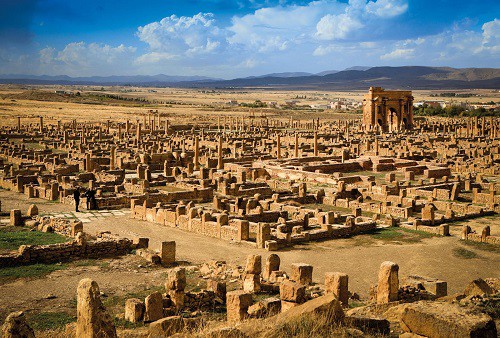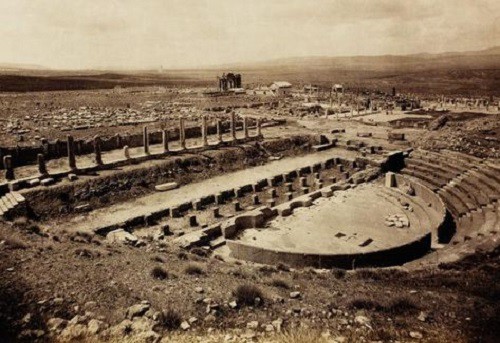Roman city of Thamugadi and the first discoveries

Thamugadi was founded by the Roman emperor Trajan. Photo: AGE FOTOSTOCK
Founded by Emperor Trajan around 100 AD, the city of Thamugadi, also known as Timgad or Tamugas, was located in the Mumidia province of North Africa. Home to veterans of the 3rd Augustan Legion, Thamugadi thrived for hundreds of years, becoming prosperous and an attractive target for invaders. After a Vandal attack in 430, repeated invasions weakened the city, leaving it unable to recover and abandoned in the 700s.
The sands of the Sahara Desert blew in and buried Thamugadi for nearly 10 centuries until the 1700s, when a group of Scottish scholars arrived. In 1763, Scottish nobleman James Bruce was serving as the British consul in the coastal city of Algiers (today the capital of Algeria). Bruce was a scholar with a wide range of interests in history and culture. Before coming to Algeria to take up his post, he spent several months in Italy studying the history of Africa and the role it played in ancient times.
After clashing with his superiors in London and being fired in 1765, rather than return to England, Bruce and a Florentine artist named Luigi Balugani set out on an adventure across Africa. During their journey, they took notes and created illustrations depicting the many extraordinary people and places they encountered.
Early in their adventure, they headed south into the Algerian desert in search of traces of ancient civilizations. Bruce and Balugani saw some Roman ruins as they explored more remote parts of the region.
On December 12, 1765, they located the site of ancient Thamugadi. Many believe they were the first Europeans in centuries to visit the site, which lies near the northern slopes of the Aurès Mountains. “It is a small town, but full of elegant buildings,” Bruce wrote in his diary. He was confident that the ruins were all that remained of the city founded by the Roman emperor Trajan more than 1,000 years earlier.
Balugani died in 1770, and Bruce returned to London in 1774. When he reported his findings, the information was met with much skepticism. By 1780, he had begun writing a memoir of his time in Africa, a five-volume work called “A Voyage to the Source of the Nile,” which was published in 1790. When Bruce died four years later, most British scholars still refused to acknowledge his achievements.
Remains of a magnificent Roman city

The city was unearthed after nearly 10 centuries buried under the sands of the Sahara. Photo: GRAND PALAIS
Thamugadi remained forgotten in the desert sands until 1875, when it was visited by Robert Lambert Playfair, a British ambassador to Algeria. In his 1877 book, Playfair paid tribute to his predecessor Bruce and provided more details about Thamugadi. His observations revealed the importance of the city to the entire region, noting that it was built at the intersection of six Roman roads.
In Mr. Playfair’s opinion, this architecture replaces the neighboring city of Lambaesis – the Nubian military capital of the ancient empire. He also concluded that Thamugadi was once a center of commercial and agricultural activity. He also described the splendor of this ancient Roman city. On the ground below the gate there are still deep grooves indicating the heavy traffic entering the city along the busy royal road.
The French took control of the site in 1881, a few years after Ambassador Playfair’s visit, and maintained a presence there until 1960. During this time, the site was systematically excavated. Despite being buried under sand for centuries, Thamugadi was fortunately not overlaid by any structures. Thamugadi is one of the few Roman cities to have been completely excavated.
Important studies
Research by Mr. Playfair and other French scholars has allowed historians to piece together the city’s history. The city was originally named Colonia Marciana Trajana Thamurga in honor of Emperor Trajan’s sister.
By the mid-third century AD, the city’s population had peaked at 15,000. It had beautiful public buildings, including a magnificent library and a total of 14 baths. The site also had a strategic role in defending the southern borders of the Roman Empire. North Africa was a center of grain production, and the 3rd Augustan Legion was stationed at Thamugadi to transport grain to Rome.
Every two years, hundreds of men would be discharged from the legion, and they would settle in Thamugadi to farm. Their presence also served as a deterrent to invaders.
The general crisis that occurred on the borders of the Roman Empire eventually took its toll on Thamugadi. After being sacked by the Vandals in the 5th century, the city began to fall into ruin. After the fall of the Roman West, Thamugadi had a brief resurgence as a Christian center, and a fortress was built outside the city in 539. However, the city was abandoned before or during the Arab invasions of the 700s.
From that point on, the Sahara gradually covered Thamugadi, and it remained hidden for 1,000 years until James Bruce and other scholars discovered it, bringing back the city’s buried glory. Thamugadi was designated a UNESCO World Heritage Site in 1982.
(According to National Geographic)




